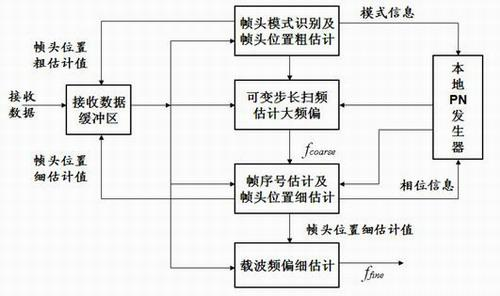Time-frequency synchronization joint estimation method based on multi-carrier receiver of digital television media broadcast (DTMB) system
A time-frequency synchronization and joint estimation technology, applied in baseband system components, multi-frequency code systems, etc., can solve the problems of large symbol position error, long time consumption, and performance degradation of symbol synchronization methods, and achieve the effect of good synchronization performance
- Summary
- Abstract
- Description
- Claims
- Application Information
AI Technical Summary
Problems solved by technology
Method used
Image
Examples
Embodiment Construction
[0028] The present invention is based on the time-frequency synchronization joint estimation method of the DTMB system multi-carrier receiver, such as figure 1 As shown, the time-frequency synchronization joint estimation is performed as follows:
[0029] Step 1: Perform sliding autocorrelation processing on the received data to identify the frame header pattern, obtain the frame header pattern, and transmit the frame header pattern information to the local PN generator;
[0030] Step 2: Based on the sliding autocorrelation result in step 1, perform a rough estimate of the frame header position, obtain a rough estimate of the frame header position, and send the rough estimate of the frame header position back to the receiving data buffer;
[0031] Step 3: The local PN generator generates a PN sequence A matching the zero phase of the frame header pattern according to the frame header pattern obtained in step 1, and based on the PN sequence A, adopts a variable step-size freque...
PUM
 Login to View More
Login to View More Abstract
Description
Claims
Application Information
 Login to View More
Login to View More - R&D
- Intellectual Property
- Life Sciences
- Materials
- Tech Scout
- Unparalleled Data Quality
- Higher Quality Content
- 60% Fewer Hallucinations
Browse by: Latest US Patents, China's latest patents, Technical Efficacy Thesaurus, Application Domain, Technology Topic, Popular Technical Reports.
© 2025 PatSnap. All rights reserved.Legal|Privacy policy|Modern Slavery Act Transparency Statement|Sitemap|About US| Contact US: help@patsnap.com



